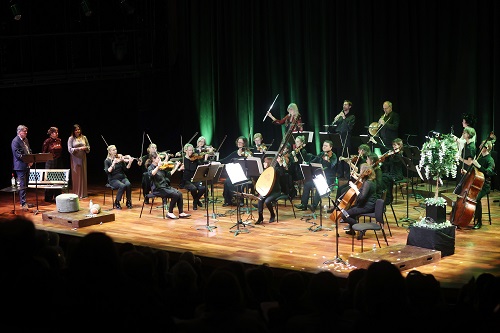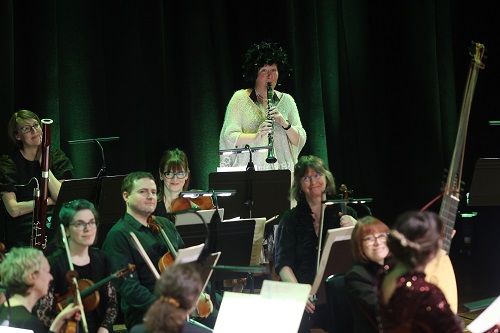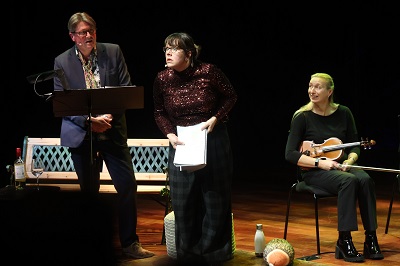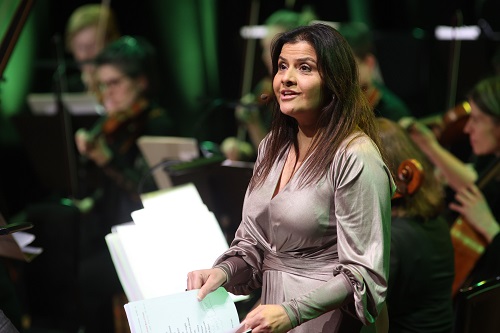‘Avian invective’ is, sadly, an all-too-common dissonance on the cyber-airwaves today. But, twittering tiffs are no modern invention: the medieval bird-debate poem tradition offers rich examples of feathery squabbles, such as Geoffrey Chaucer’s Parliament of Fowls. Following his renditions in modern English of Pearl (a poem about the loss of a child), Thomas Malory’s The Death of King Arthur and Sir Gawain and the Green Knight, in 2021 Simon Armitage turned his attention to The Owl and the Nightingale, an anonymous debate poem formed of almost 900 rhyming couplets in octosyllabic tetrameter, which Armitage has described as ‘a medieval slang-match’.
Neither the date (speculation has ranged from the 1190s to the 1270s) nor place of origin of The Owl and the Nightingale are known, nor why it was written. The poem recounts a series of increasingly vexed verbal exchanges between an owl and a nightingale, as overheard by an anonymous first-person narrator, which roves across diverse subjects – love, religion, hedonism, class distinctions and the right to be heard. As they fling insults and accusations back and forth, sarcastically skewering each other’s flaws, the rising hostility threatens to erupt in actual violence, until the two birds decide to depart for Dorset to ask one Master Nicholas of Guildford – in his version, Armitage himself – to be the arbiter of their dispute. The judgement made by this ‘magistrate’, ‘skilled with words & worldly wise’, is not known to our narrator, and so the poem endorses neither bird’s position. The absence of a ‘verdict’ – and the anthropomorphised birds’ ‘human’ qualities and concerns – has invited numerous and various allegorical interpretations, pitting against each other opposing philosophies or outlooks, relating to matters such as preaching methods or types of poetry.

Whatever The Owl and the Nightingale is ‘about’, the poem is itself evidence that its author was concerned with secular poetry and the art of rhetoric – and with ‘performance’. Ruffled by the robustness of the Owl’s rebuttal, the Nightingale takes a moment to mull things over, concerned that ‘now it was her turn to speak her logic might sound false or weak’. The narrator tells us: ‘But she was bold & held her nerve, &, wisely, spoke with guts & verve … And so, despite all doubts & fears, the Nightingale was loud & clear.’ In turn, the Owl takes her time to digest the Nightingale’s declaration that her own enchanting song of love and truth is far superior to the ‘miserable & gloomy tune’ that the Owl croons all winter, ‘for those aware of verbal tricks must cautiously assess the risks’.
Moreover, the birds’ exchanges are both interrupted by their melodising and interrogate the aesthetics of song and performance. The narrator recounts:
‘The birds, both swollen up with anger,
hurled abuse at one another,
taking turns to slate & curse
what in the other bird was worst,
with insults being especially strong
when rubbishing the other’s song.’
One might see the bickering birds as rival divas, perhaps. And, towards the end of the poem, when the Nightingale, taunting the Owl that the latter has conceded her case, perches and issues her ‘most resounding notes’, a feathered host – orioles, thrushes, bird big and small – flocks to the scene believing the Nightingale to be the victor: ‘& from the branches they gave voice as if the trees themselves rejoiced.’
One critic[1] has gone so far as to propose that music is the central theme of the poem, arguing that the Owl and the Nightingale represent Gregorian chant and secular troubadour music respectively. And, if to see the poem as essentially a treatise on singing seems to exclude so much ‘else’ – from birds’ nesting habits, to fornication, to astrology – that the poem traverses, then it’s certainly the case that The Owl and the Nightingale seems to invite not just performance but musical embodiment. And, that’s what the City of London Sinfonia provided at the Queen Elizabeth Hall, presenting a beautifully curated programme of works, many with an avian theme, to accompany a presentation of the poem by Armitage (as Narrator) with Kerry Godliman and Nina Wadia as the Nightingale and Owl respectively.

Relentless toxic chirruping might be clamorous but music can bring opposing arguments together in concordant ways – indeed, counterpoint creates rhythm energy, melodic dialogue and harmonic synthesis. And so, as Godliman’s Nightingale settled stage-left onto her perch within a ‘densely knotted hedge entwined with reeds & bright green sedge‘ and ‘gloried in that branch’, and Wadia’s Owl nestled down dourly on her ‘tree-stump’ on the opposite side of the stage, nature was given voice by Karen Jones’s flute and Katherine Spencer’s clarinet. As they entered the Hall through the audience, the free improvisations of the ‘Misterioso’ from Pēteris Vasks’ Wind Quintet No.1 (Music for fleeting birds) unfolded onomatopoeically, creating an expectant mood which was subsequently enhanced by the haunting hues – nature’s night-time drones and whirrs – of the Adagio. Mesto from Ligeti’s Six Bagatelles for Wind Quartet. Birdsong also ‘literally’ twittered in Couperin’s ‘Le Rossignol en amour’ from the composer’s third book of harpsichord works, in which the mordents and trills beautifully decorated the drooping melodic line, and in an excerpt from Janequin’s well-known Le chant des oiseaux.
The avian antagonists were differentiated through musical encounters of various kinds. The title of Harrison Birtwistle’s Duet 4, ‘Violute’, conflates the violin and flute just as the music entwines the two instruments in an incessant stream of agitated outbursts. One of a series of duets composed by Birtwistle for the London Sinfonietta, it’s been recorded by CLS’s leader and creative director, Alexandra Wood (with flautist Michael Cox), and here she and Jones relished the uncompromising back-and-forth, capturing both the tension and the wit. The narrator tells us that the Nightingale’s branch ‘formed a kind of stage, & she performed the music of her repertoire as if she played a pipe or harp, as if each bright melodious note were not the product of a throat’, so Vivaldi’s Flute Concerto RV433 (‘La tempesta di mare’) was a fitting inclusion, and Jones effortlessly spun the semiquavers like silk, her sneakers sparkling as vibrantly as the Nightingale’s florid song.

Huw Watkins’s ‘Five Duos’ was composed for the CLS’s 50th anniversary and premiered by Wood and Spencer during the orchestra’s Origin series in October 2021. Subtly ‘folky’, the first movement brought out the contrasting colours and characteristics of the two instruments, as the spare lines conversed and complemented each other. Not all of the poetic conversations are fiercely combative: there are points were, albeit temporarily, the birds listen to each other’s arguments and acknowledge their persuasiveness, and reconciliation does occasionally seem possible. The first-movement Allegro of J.S. Bach’s Concerto for oboe and violin, in which Wood was joined by Owen Dennis, embodied this more positive spirit of debate – an eloquent, sweet-toned exchange between equals.
Other works conveyed the hostility between the warring winged creatures, however. Purcell’s ‘Rondeau’ from Abdelazar seemed to swell with the Owl’s indignation and righteousness, all puffed up chest and weighty solemnity. Biber subtitled his Battalia for ten-part string ensemble, ‘the dissolute roaming of the Musketeers, Mars [March], the Battle, the Lament [or Moaning] of the wounded, with imitative Arias, dedicated to Bacchus’, and there was something quasi-bacchanal about the CLS’s rousing delivery of Biber’s imitative ‘musical theatre’, particularly the explosive twang of the percussive Bartók-pizzicatos in ‘Die Schlacht’ (The Battle), which turned the hot-headed bird-spats into cannon fire. In contrast, an extract from the first-movement Largo of Shostakovich’s Chamber Symphony was a reminder of the horror and tragedy of war. Wood’s leadership throughout was exemplary and clearly inspiring. She plays with tremendous authority and presence, but she uses these qualities not simply to direct but rathers to draw the best from her fellow musicians. Their collaborative harmony was wryly ironic given the poetic context their music served to illustrate and elaborate.

Directed by Jenifer Toksvig, from their respective perches the birds conducted their acrimonious dispute with vigour and verve, the relentless insults – and Armitage’s skilful use of single-syllable words which, driven by plosive alliteration, bounced back and forth – creating compelling energy. They were overlooked by an urbane Armitage who stood at a lectern to offer calm observations, then seated himself on a garden bench to enjoy the unfolding dramas of the pique-laced debate. The sober seriousness and righteous sincerity of Godliman’s Owl were palpable – her eyes fixed firmly on the ground, she really did ‘[sit] there ready to explode,/ like someone choking on a toad’ – as was her growing frustration and frightening fury. When she stalked across the stage, trying to entice her opponent into the open, no wonder the Nightingale declined. Wadia’s Nightingale was joyful and flighty, her cheerful chirping condemned as ‘exhibitionist display’ but a pleasing antidote to the Owl’s ponderous pieties. And, Wadia conveyed the surprising sophistication of the tunesmith, who is not such a trivial lightweight as the Owl asserts.
The exchanges were vitriolic but witty too; both petty and profound. The more personal the insult, the more ribald and vulgar. ‘You roost by day & fly by night which proves that something isn’t right’ jibed the Nightingale breezily, but her tone turned nasty when she denigrated the ‘brood of dirty-looking pests you’re raising in a filthy nest’, while the Owl fairly spat out the contemptuous slur on her rival’s nocturnal habitats: ‘At night, while I pursue the mouse you loiter by that smelly house perched on a nettle or a reed, at song behind the toilet seat.’ Wadia and Godliman relished the verbal jousting and jesting. And, more than that, they made it fun – as it is surely intended to be.
Near the start of the poem, the Owl proposes that perhaps they should begin afresh, ‘& this time act with greater courtesy & tact … Let’s state with dignity and pride our point, positions & beliefs in measured tones & reasoned speech’, a suggestion embodied by the stylish, well-judged nature of this super performance.
Claire Seymour
The Owl and the Nightingale: Simon Armitage (narrator), Kerry Godliman (The Owl), Nina Wadia (The Nightingale), Jenifer Toksvig (director), Alexandra Wood (leader, creative director), City of London Sinfonia
Pēteris Vasks – ‘Misterioso’ from Wind Quintet No.1 (Music for fleeting birds); Ligeti – Adagio. Mesto from 6 Bagatelles for wind quintet; Purcell – ‘Rondeau’ from Abdelazer; Bach – ‘Allegro’ from Concerto for oboe and violin BWV 1060; Couperin – ‘Le rossignol-vainqueur’ from Pièces de clavecin Ordre No.14; Biber – Presto and ‘Die Schlacht’ from Battalia à 10 in D; Couperin – ‘Le rossignol-en-amour’; Vivaldi – Flute Concerto in F RV 433 (La Tempesta di mare) Op.10 No.1; Shostakovich – excerpt from Largo from Chamber Symphony in C minor Op.110a (arr. Barshai); Huw Watkins – Allegro molto from 5 Duos for clarinet and violin; Ligeti – ‘Rubato lamentoso’ from 6 Bagatelles for wind quintet; Telemann – Etwas lebhaft from ‘Grillen-Symphonie’ (Cricket Symphony)
Queen Elizabeth Hall, Southbank Centre, London; Saturday 14th January 2023.
ABOVE: The Owl and the Nightingale. Image courtesy of Bodleian Library, Oxford.
[1] Bertram Colgrave, ‘The Owl and the Nightingale and the “Good Man from Rome”’, English Language Notes 4 (1966), pp.1-4.